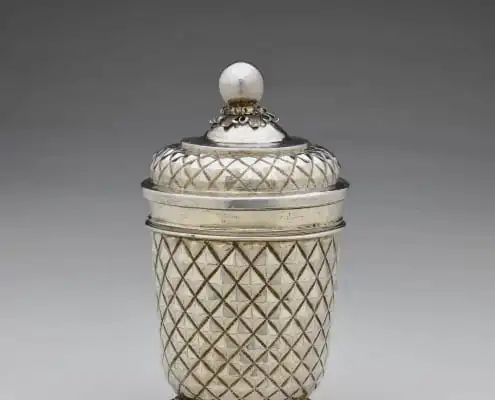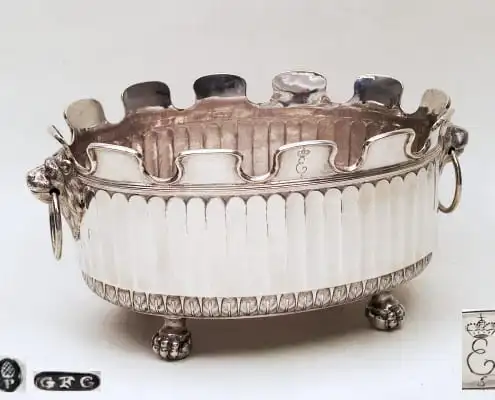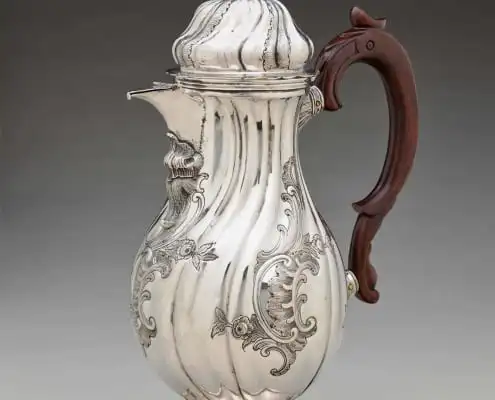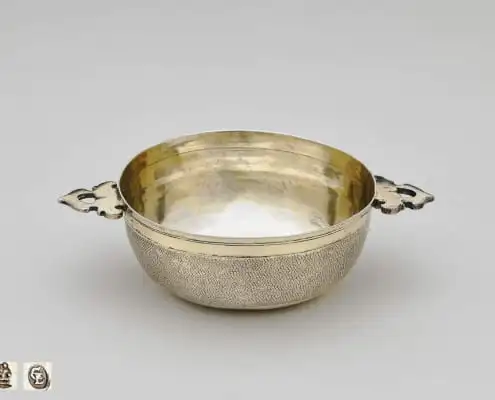European Drinking Culture: Sixteenth to Eighteenth Century
Banquet of Rudolph II (detail of drinking vessels and other eating utensils), Vienna, Kunsthistorisches Museum
“In vino veritas”“
Many antique silver objects are connected to basic necessary activities of men, like eating and drinking. Yet, the material culture of those activities is connected to unique examples of the decorative arts throughout history. With this article, we would like to throw our special focus onto the European drinking culture and go through some interesting facts and types of historical drinking vessels made of silver.
Why do people drink? Since ancient times, drinking has been connected with special celebrations like the birth of a child, marriage, funeral, engagement or other rituals. Drinking marked transitions, for instance, the end of a workday or the beginning of it. In any case, in many cultures drinking was and still is related to alcohol.
European drinking culture has a long tradition and history. In literature, as well as in different semi-scientific and scientific investigations, wine and other drinks were the subject of numerous treatises and works since Antiquity.
In the Middle Ages and early modern times, wine, beer, ale, cider or other local drinks were preferred to water as drink. Water was very often contaminated with pathogens while the beer, for instance, with its content (alcohol, carbonic acid and a low pH-value) reduced the risk of infection. Besides, beer had a high nutritional value, especially for populations which based their diet on cereals. Beer became an important part of the European diet for men, women and children alike.
On the European continent, drinking has inspired a large variety of works of art and material culture. Each country has its own drinking history and traditions, yet in many cases mutual influences and similarities are easy to trace. The history of drinking culture is related to the flourishing of decorative arts and the constant innovation and beauty of the artistic domains. Besides, it is related as well to the history of food, new alimentary products, commercial relations, science, luxury and political events.
Beer, wine and other drinks
The prerequisites to the production of beer appeared around 7000 BC, and those for wine production around 5000 BC. Traces of beer in a range of variations have been found in ancient deposits in China but there is also evidence showing that even earlier, considerable production of beer occurred in Mesopotamia, Egypt and other countries. The Greeks and the Romans did not drink beer. Nonetheless, beer production and consumption were considerable on the borders of the Roman Empire, while the Romans used beer for medical purposes.
Nobility usually drank wine as more appropriate for their rank (an idea going back to the Greek and Roman times), but in reality, the middle class, priests and citizens consumed beer, a drink that turned into an essential part of the daily life. Gradually, beer attained the position of a nutritional product and an important commercial staple from the 12th century on.
The Germans adopted beer production from the Celts. The task was accomplished in the household by women. This habit continued until the late 18th century. In some areas like Silesia, a daughter would inherit the beer brewing utensils by which the tradition would pass from generation to generation. Interestingly, in England, the production of beer and ale was assigned to women as well.
Hop growing rose in importance in the 15th century in cities such as Nuremberg, and this agricultural, cultural and economic development, coupled with higher wine prices, led people to increasingly consume beer in the 15th and 16th centuries. Beer was designated as “liquid bread” due to its high nutritional value, especially for populations which based their diet on cereals. For that reason, beer became a basis for meals such as soups or bread. Clergymen, monks and officials profited not only nutritionally but also economically, especially that the former brewed their own beer and the latter controlled a lot of breweries.
Seafarers and sea-nations as well contributed to the popularity of beer as the drink ensured considerable amounts of liquid supplies and was non-perishable, which made it perfect for long journeys. This was also one of the reasons why the leading sea powers, which consumed high quantities of beer, were instrumental in developing beer brewing processes.
Consequently, the growing importance of beer and the always important for different occasions wine stimulated the production of vessels dedicated to them since the 16th century, such as tankards, wine goblets, ewers, and other.
Quite a few drinks were consumed cold or chilled. Hot drinks (often mixed with spices) were particularly favoured in wintertime. Throughout the centuries, a variety of drinking vessels with a cover have been in use for the better preservation of the tempered wine

Wine could be tempered, and wine glasses chilled in specially designed vessels filled with ice (the monteith bowl), quite an expensive commodity itself in the 18th century. Separate wine coolers for chilling wine bottles were increasingly in use since the late 17th century. During the Enlightenment, a period marked by the great influence of the French court’s rules and customs, imposing large vessels were made, such as the pair of wine bottle coolers from a service of Catherine the Great (1729-1796).


From the 16th century on and particularly in the 17th century, one can observe that a lot of diet changes appeared in Europe, coming – almost parallelly – from Asia, Amerika and Africa. Innovations in the drinking habits of the European elites ensued. They had economic roots and involved products of exotic origin. By the 18th century, the newly introduced warm beverages: coffee, tea and cacao, began to conjure an aura of consumption, delight, luxury and fashion.
Dominated by the French table culture habits, the 18th century celebrated elegant food arrangements, decorative pieces of uniform design, glamorous materials and ceremoniousness. Formal and ritual functions were attached also to new beverages, for which special receptacles were designed. The popularity of the warm beverages – along with that of sugar, another inseparable luxurious commodity – led to further changes in the consumption of beer and wine.

In the course of the 18th century and later, brandy, a by-product of wine, added new value to the pleasures of drinking among a greater part of society. Finally, the consumption of vodka grew steadily over the 18th century. Its history goes back to the 15th century, however, this spirit of relatively late invention was not incorporated into drinking rituals in the 17th century but only later on. Nonetheless, the drink took pride of place in Russian drinking and ceremonial cultures. Traditionally made chiefly in Poland and Russia, it was also consumed in Ukraine, Sweden and Finland. In North Germany the drink was also popular and, as in the rest of Western Europe, drunk and enjoyed by aristocrats as a rare Eastern European specialty until the end of the 19th century.
A social and cultural act
Whatever the drink, drinking is an essentially social act rounded out by other cultural rites. In almost every culture, drinking is connected to social events, political occasions, official affairs as well as cultural and popular shaped ideas and habits.
Other than that, drinking offered in the past an occasion to offer gifts of all ranges: political, diplomatic, religious. Common christening and wedding gifts in Northern Europe during the sixteenth and seventeenth century were silver tankards and wine cups or beakers.
Meal and the drink had particularly significance in ceremonial feasting customs amongst nobility. Ceremonious drinking at court included exchanging precious drinking vessels in public, a strict protocol and toasts accompanied by trumpets and drum rolls. Feasts would open with wine tasting ceremonies using wine-tasters (tastevin) held before the monarch.

Since the Middle-Ages, men of power tried to outbid each other in a display of splendour and hospitality. Often, during courtly feasts, it was necessary to make the social or political status of the guests immediately recognizable. On such occasions, a buffet would be put up, on which drinking vessels were displayed in multiple layers, depending on the user’s rank.
During the centuries, neither religious preaches nor wars nor other illnesses managed to stop the consumption of alcohol or production of drinking vessels. In the 16th and 17th centuries, luxury silver grew in prominence due to the increasing import of precious metals from South America. Royal courts multiplied commissions for magnificent works in silver.
The various drinks are linked to specific drinking vessel types made of silver. Wine, beer, tea, coffee, chocolate, spirits and liqueurs help us trace back the aesthetical and cultural history, of drinking vessels designed on the European continent. They do not only represent tangible cultural heritage but are also tokens of social class, wealth and gender in the early modern times.


